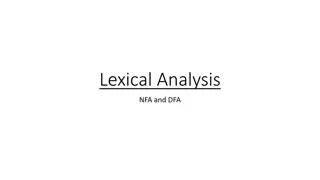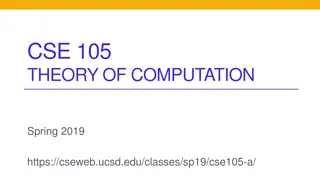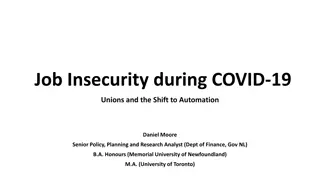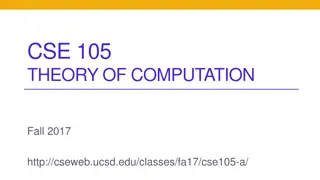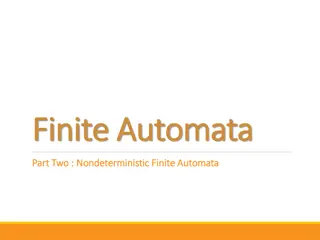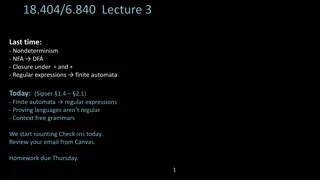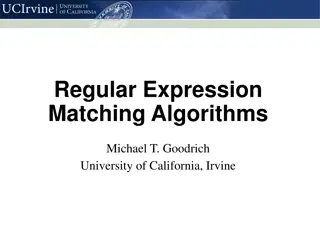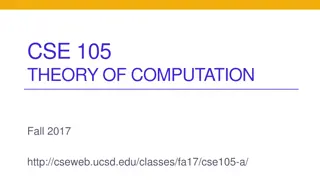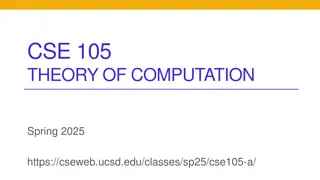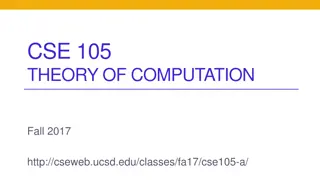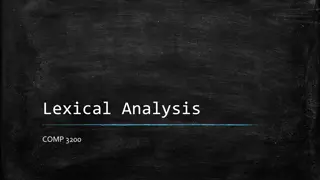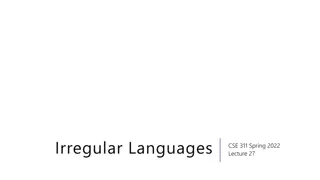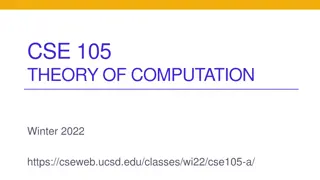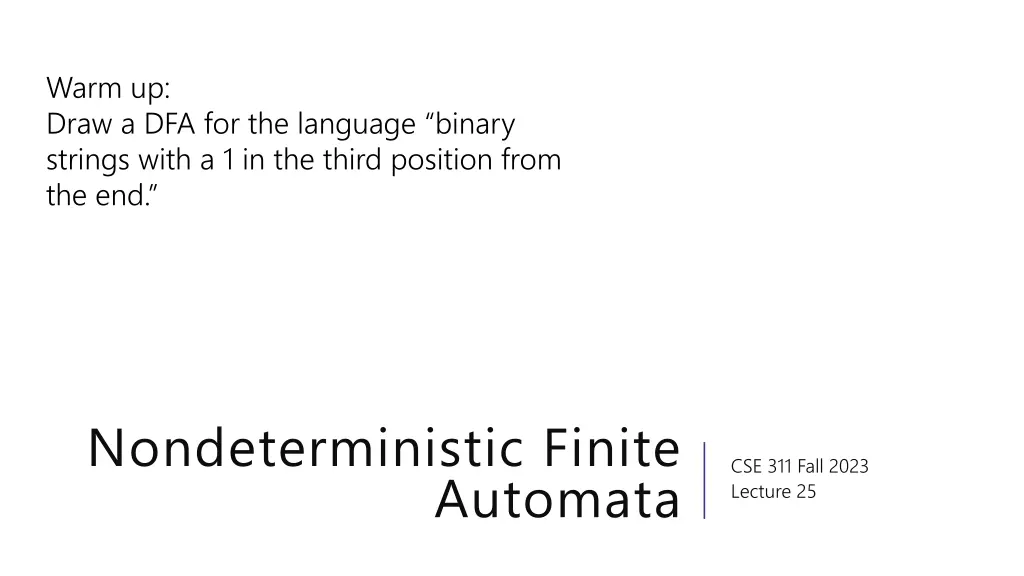
Binary Strings Third Position DFA
Explore how to construct a Deterministic Finite Automaton (DFA) for the language of binary strings with a 1 in the third position from the end. Understand the construction process involving the cross-product construction and the necessary considerations while designing the DFA.
Uploaded on | 1 Views
Download Presentation

Please find below an Image/Link to download the presentation.
The content on the website is provided AS IS for your information and personal use only. It may not be sold, licensed, or shared on other websites without obtaining consent from the author. If you encounter any issues during the download, it is possible that the publisher has removed the file from their server.
You are allowed to download the files provided on this website for personal or commercial use, subject to the condition that they are used lawfully. All files are the property of their respective owners.
The content on the website is provided AS IS for your information and personal use only. It may not be sold, licensed, or shared on other websites without obtaining consent from the author.
E N D
Presentation Transcript
Warm up: Draw a DFA for the language binary strings with a 1 in the third position from the end. Nondeterministic Finite CSE 311 Fall 2023 Lecture 25 Automata
Strings over {0,1,2} w/ even number of 2s and sum%3=0 Changed notation final states with bold outlines. 0 0 s0t0 s1t0 2 2 1 1 0 0 2 2 1 s0t1 s1t1 1 1 1 Called the cross product construction (because you have a set of states equal to ?1 ?2 where first two DFAs had states ?1,?2. A very common trick to combine DFAs. 2 2 s0t2 s1t2 0 0
More formally (the cross product construction ) The constructed DFA States: ?1 ?2 Start state: (?0,?0 Transition function: ?((?,? ),?) = (?1?,? ,?2(? ,?). Outputs ordered pair of states to transition to. Final States: Varies. E.g. For strings accepted by both machines, ?1 ?2 For strings accepted by at least one machine, ?1 ?2 ?1 ?2 The original DFAs States: ?1,?2 Start state: ?0,?0 Transition function: ?1?,? ,?2(?,?) Outputs state transitioned to on input ? from ? Final States: ?1,?2 )
The set of binary strings with a 1 in the 3rd position from the start
The set of binary strings with a 1 in the 3rd position from the start R 0,1 0 0,1 0,1 1 s0 s1 s2 A 0,1
The set of binary strings with a 1 in the 3rd position from the end What do we need to remember? We can t know what string was third from the end until we have read the last character. So we ll need to keep track of the character that was 3 ago in case this was the end of the string. But if it s not we ll need the character 2 ago, to update what the character 3 ago becomes. Same with the last character.
3 bit shift register Remember the last three bits 1 011 001 0 1 1 1 1 1 010 101 111 0 1 000 0 0 1 0 0 0 100 110 0
The set of binary strings with a 1 in the 3rd position from the end 0 1 0 1 0 1 0 1 11 10 00 01 1 1 1 1 0 0 0 0 1 011 001 0 1 1 1 1 1 010 101 111 0 1 000 0 0 1 0 0 0 100 110 0
The set of binary strings with a 1 in the 3rd position from the end 1 011 001 0 1 1 1 1 1 010 101 111 0 1 000 0 0 1 0 0 0 100 110 0
The beginning versus the end R 0 0,1 0,1 0,1 1 s0 s1 s2 A 0,1 1 011 001 0 1 1 1 1 1 010 101 111 0 1 000 0 0 1 0 0 0 100 110 0
From the beginning was easier than from the end At least in the sense that we needed fewer states. That might be surprising since a java program wouldn t be much different for those two. Not being able to access the full input at once limits your abilities somewhat and makes some jobs harder than others.
What language does this machine recognize? 1 s0 s1 1 0 0 0 0 1 s2 s3 1
What language does this machine recognize? 1 s0 s1 1 0 0 0 0 1 s2 s3 1 #1s even #1s odd
What language does this machine recognize? 1 s0 s1 #0s even 1 0 0 0 0 1 s2 s3 #0s odd 1
What language does this machine recognize? 1 s0 s1 1 0 0 #0s is congruent to #1s (mod 2) 0 0 Wait there s an easier way to describe that . 1 s2 s3 1
What language does this machine recognize? 1 s0 s1 That s all binary strings of even length. 1 0 0 0,1 0 0 s0 s1 1 0,1 s2 s3 1
Takeaways The first DFA might not be the simplest. Try to think of other descriptions you might realize you can keep track of fewer things than you thought. Boy it d be nice if we could know that we have the smallest possible DFA for a given language
DFA Minimization We can know! Fun fact: there is a unique renaming the states) High level idea final states and non-final states must be different. Otherwise, hope that states can be the same, and iteratively separate when they have to go to different spots. unique minimum DFA for every language (up to Some quarters this covered in detail. But we ran out of time. Optional slides won t be required in HW or final but you might find it useful/interesting for your own learning.
Optional Content: Machines with output
What are FSMs used for? Classic hardware applications: Anything where you only need to remember a very small amount of information, and have very simple update rules. Vending machines Elevators: need to know whether you re going up or down, where people want to go, where people are waiting, and whether you re going up or down. Simple rules to transition. These days general hardware is cheap, less likely to use custom hardware. BUT the programmer was probably still thinking about FSMs when writing the code.
What are FSMs used for? Theoretically still lots of applications. grep uses FSMs to analyze regular expressions (more on this later). Useful for modeling situations where you have minimal memory. Good model for simple AI (say simple NPCs in games). Technically Technically all of our computers are finite state machines But they re not usually how we think about them more on this next week.
Adding Output to Finite State Machines So far we have considered finite state machines that just accept/reject strings called Deterministic Finite Automata or DFAs One can also consider finite state machines that with output These are often used as controllers
Vending Machine Enter 15 cents in dimes or nickels Press S or B for a candy bar
Vending Machine, v0.1 D D N N, D N 0 5 10 15 B, S Basic transitions on N (nickel), D (dime), B (butterfinger), S (snickers)
Vending Machine v0.2 D D N N, D N 0 5 10 15 B, S
Vending Machine, v0.2 D 0 N 15 D D B N S 0 [B] N N 5 10 D 15 [N] B S N D 0 [S] Adding output to states: N Nickel, S Snickers, B Butterfinger
Vending Machine, v1.0 B,S D 0 N 15 B,S D B,S B D B,S D N S N 0 [B] N 5 10 D N 15 [N] B N S D B,S N N D B 0 [S] 15 [D] S D Adding additional unexpected transitions to cover all symbols for each state
NFAs, Power of machines
Lets try to make our more powerful automata We re going to get rid of some of the restrictions on DFAs, to see if we can get more powerful machines (i.e. can recognize more languages). From a given state, we ll allow any number of outgoing edges labeled with a given character. The machine can follow any of them. We ll have edges labeled with ? the machine (optionally) can follow one of those without reading another character from the input. If we get stuck i.e. the next character is ?and there s no transition leaving our state labeled ?, the computation dies.
Nondeterministic Finite Automata An NFA: Still has exactly one start state and any number of final states. The NFA accepts ? if there is some path from a start state to a final state labeled with ?. From a state, you can have 0,1, or many outgoing arrows labeled with a single character. You can choose any of them to build the required path. 1 1 1 s3 s0 s1 s2 0,1 0,1
Wait a second But how does it know? Is this realistic?
Three ways to think about NFAs Outside Observer Outside Observer : is there a path labeled by ? from the start state, to the final state (if we know the input in advance can we tell the NFA which decisions to make) Perfect Guesser Perfect Guesser : The NFA has input ?, and whenever there is a choice of what to do, it magically magically guesses a transition that will eventually lead to acceptance (if one exists) Parallel exploration Parallel exploration : The NFA computation runs all possible computations on ? in parallel (updating each possible one at every step)
Somagic guessing doesnt exist I know. The parallel computation view is realistic. Lets us give simpler descriptions of complicated objects. This notion of nondeterminism is also really useful in more advanced CS theory (you ll see it again in 421 or 431 if not sooner). Source of the P vs. NP problem.
NFA practice What is the language of this NFA? 0,1 1 1 s3 s2 s1 1 s0 0 1 s5 s4 1
NFA practice What is the language of this NFA? 0,1 1 1 111 0 1 s3 s2 s1 1 s0 0 1 s5 Overall 111 0 1 [10 10 ] 10 10 s4 1
What about those ?-transitions? 2 0,1 0,1 s0 s1 2 0 q t1 1 1 0 2 2 0 t2 t0 2 1
What about those ?-transitions? 2 0,1 0,1 s0 s1 2 The set of strings over {0,1,2} with an even number of 2 s or the sum %3 = 0. 0 q t1 1 1 0 2 2 0 t2 2 t0 1
NFA that recognizes binary strings with a 1 in the third position from the end Perfect Guesser Perfect Guesser : The NFA has input ?, and whenever there is a choice of what to do, it magically magically guesses a transition that will eventually lead to acceptance (if one exists) Perfect guesser view makes this easier. Design an NFA for the language in the title.
NFA that recognizes binary strings with a 1 in the third position from the end 0,1 0,1 0,1 1 s s0 0 s s1 1 s s2 2 s s3 3 That s WAY easier than the DFA
Parallel Exploration view of an NFA 0,1 0,1 0,1 1 s s0 0 s s1 1 s s2 2 s s3 3 Input string 0101100 0 0 1 1 0 1 0 s s3 3 s s3 3 s s3 3 s s3 3 s s3 3 s s3 3 s s3 3 s s3 3 s s0 0 s s1 1 s s2 2 s s0 0 X s s1 1 s s2 2 s s0 0 X s s1 1 s s2 2
Regularity So NFAs/DFAs what can and can t they do? Can NFAs do more than DFAs? How do they relate to context-free-grammars? Regular expressions? i.e. is there a language ? such that ? is the language of an NFA but not a DFA? Or vice versa? What about CFGs/regexes? pollev.com/robbie
Regularity So NFAs/DFAs what can and can t they do? Can NFAs do more than DFAs? How do they relate to context-free-grammars? Regular expressions? Kleene s Theorem For every language ?: ? is the language of a regular expression if and only if ? is the language of a DFA if and only if ? is the language of an NFA
Regularity So NFAs, DFAs, and regular expressions are all equally powerful Every language either can be expressed with any of them or none of them. A set of strings that is recognized by a DFA (equivalently, recognized by an NFA; equivalently, the language of a regular expression) is called a regular language language. regular So to show a language is regular you just need to show one of these and prove it works. There are some irregular languages (that don t have a corresponding NFA/DFA/regex). CFGs are more powerful (every regular language can also be represented with a CFG, but some languages with CFGs have not NFA/DFA/regex.
Proof [sketch] ? is the language of an NFA. ? is the language of a regular expression. ? is the language of a DFA. This is just a sketch of the proof. We want you to get the intuition for why this is true, we ll go very quickly for some cases.
Proof [sketch] ? is the language of an NFA. ? is the language of a regular expression. ? is the language of a DFA. Suppose ? is the language of some DFA ?. ? also satisfies the requirements for an NFA, so ? is also the language of an NFA.
Proof [sketch] ? is the language of an NFA. ? is the language of a regular expression. ? is the language of a DFA.
Can we convert an NFA to a DFA? NFAs are magic though! DFAs can t guess Parallel exploration: Parallel exploration: The NFA computation runs all possible computations on x step-by-step at the same time in parallel At any step, the set of all possible states we could be in is fixed! And the update steps are deterministic if we just check all possibilities!
Parallel Exploration view of an NFA 0,1 0,1 0,1 1 s s0 0 s s1 1 s s2 2 s s3 3 Input string 0101100 0 0 1 1 0 1 0 s s3 3 s s3 3 s s3 3 s s3 3 s s3 3 s s3 3 s s3 3 s s3 3 s s0 0 s s1 1 s s2 2 s s0 0 X s s1 1 s s2 2 s s0 0 X s s1 1 s s2 2
Can we convert an NFA to a DFA? NFAs are magic though! DFAs can t guess Parallel exploration: Parallel exploration: The NFA computation runs all possible computations on x step-by-step at the same time in parallel At any step, the set of all possible states we could be in is fixed! And the update steps are deterministic if we just check all possibilities!


